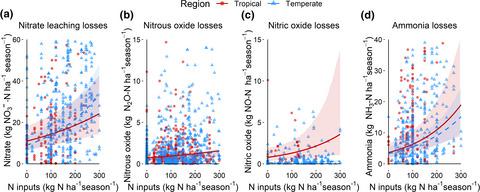当前位置:
X-MOL 学术
›
Glob. Change Biol.
›
论文详情
Our official English website, www.x-mol.net, welcomes your
feedback! (Note: you will need to create a separate account there.)
Meta-analysis on the potential for increasing nitrogen losses from intensifying tropical agriculture.
Global Change Biology ( IF 10.8 ) Pub Date : 2020-01-26 , DOI: 10.1111/gcb.14951 Alexandra M Huddell 1 , Gillian L Galford 2, 3 , Katherine L Tully 4 , Cynthia Crowley 2, 5 , Cheryl A Palm 6 , Christopher Neill 7 , Jonathan E Hickman 8 , Duncan N L Menge 1
Global Change Biology ( IF 10.8 ) Pub Date : 2020-01-26 , DOI: 10.1111/gcb.14951 Alexandra M Huddell 1 , Gillian L Galford 2, 3 , Katherine L Tully 4 , Cynthia Crowley 2, 5 , Cheryl A Palm 6 , Christopher Neill 7 , Jonathan E Hickman 8 , Duncan N L Menge 1
Affiliation

|
Fertilized temperate croplands export large amounts of reactive nitrogen (N), which degrades water and air quality and contributes to climate change. Fertilizer use is poised to increase in the tropics, where widespread food insecurity persists and increased agricultural productivity will be needed, but much less is known about the potential consequences of increased tropical N fertilizer application. We conducted a meta-analysis of tropical field studies of nitrate leaching, nitrous oxide emissions, nitric oxide emissions, and ammonia volatilization totaling more than 1,000 observations. We found that the relationship between N inputs and losses differed little between temperate and tropical croplands, although total nitric oxide losses were higher in the tropics. Among the potential drivers we studied, the N input rate controlled all N losses, but soil texture and water inputs also controlled hydrological N losses. Irrigated systems had significantly higher losses of ammonia, and pasture agroecosystems had higher nitric oxide losses. Tripling of fertilizer N inputs to tropical croplands from 50 to 150 kg N ha-1 year-1 would have substantial environmental implications and would lead to increases in nitrate leaching (+30%), nitrous oxide emissions (+30%), nitric oxide (+66%) emissions, and ammonia volatilization (+74%), bringing tropical agricultural nitrate, nitrous oxide, and ammonia losses in line with temperate losses and raising nitric oxide losses above them.
中文翻译:

关于热带农业集约化增加氮损失潜力的荟萃分析。
施肥的温带农田输出大量的反应性氮(N),这会降低水和空气质量,并助长气候变化。在热带地区,肥料的使用有望增加,因为那里普遍存在粮食不安全状况,需要提高农业生产率,但是人们对增加热带氮肥的潜在后果知之甚少。我们对热带地区的硝酸盐浸出,一氧化二氮排放,一氧化氮排放和氨挥发进行了荟萃分析,总共观测了1000多个。我们发现,尽管热带地区的一氧化氮总损失较高,但温带和热带农田中氮素投入与损失之间的关系几乎没有差异。在我们研究的潜在驱动因素中,N个输入速率控制了所有N个损耗,但是土壤质地和水分输入也控制了水文氮的损失。灌溉系统的氨损失明显更高,而牧场农业生态系统的一氧化氮损失则更高。第1年向热带农田输入的肥料N的三倍从50到150 kg N ha-1将对环境产生重大影响,并将导致硝酸盐浸出(+ 30%),一氧化二氮排放量(+ 30%),一氧化氮增加(+ 66%)的排放和氨的挥发(+ 74%),使热带农业硝酸盐,一氧化二氮和氨的损失与温带损失保持一致,并使一氧化氮的损失增加。
更新日期:2020-01-27
中文翻译:

关于热带农业集约化增加氮损失潜力的荟萃分析。
施肥的温带农田输出大量的反应性氮(N),这会降低水和空气质量,并助长气候变化。在热带地区,肥料的使用有望增加,因为那里普遍存在粮食不安全状况,需要提高农业生产率,但是人们对增加热带氮肥的潜在后果知之甚少。我们对热带地区的硝酸盐浸出,一氧化二氮排放,一氧化氮排放和氨挥发进行了荟萃分析,总共观测了1000多个。我们发现,尽管热带地区的一氧化氮总损失较高,但温带和热带农田中氮素投入与损失之间的关系几乎没有差异。在我们研究的潜在驱动因素中,N个输入速率控制了所有N个损耗,但是土壤质地和水分输入也控制了水文氮的损失。灌溉系统的氨损失明显更高,而牧场农业生态系统的一氧化氮损失则更高。第1年向热带农田输入的肥料N的三倍从50到150 kg N ha-1将对环境产生重大影响,并将导致硝酸盐浸出(+ 30%),一氧化二氮排放量(+ 30%),一氧化氮增加(+ 66%)的排放和氨的挥发(+ 74%),使热带农业硝酸盐,一氧化二氮和氨的损失与温带损失保持一致,并使一氧化氮的损失增加。











































 京公网安备 11010802027423号
京公网安备 11010802027423号